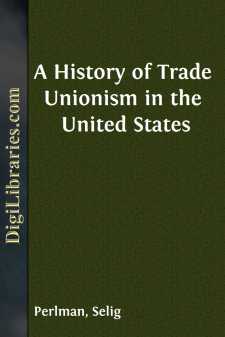Categories
- Antiques & Collectibles 13
- Architecture 36
- Art 48
- Bibles 22
- Biography & Autobiography 813
- Body, Mind & Spirit 142
- Business & Economics 28
- Children's Books 14
- Children's Fiction 11
- Computers 4
- Cooking 94
- Crafts & Hobbies 4
- Drama 346
- Education 46
- Family & Relationships 57
- Fiction 11829
- Games 19
- Gardening 17
- Health & Fitness 34
- History 1377
- House & Home 1
- Humor 147
- Juvenile Fiction 1873
- Juvenile Nonfiction 202
- Language Arts & Disciplines 88
- Law 16
- Literary Collections 686
- Literary Criticism 179
- Mathematics 13
- Medical 41
- Music 40
- Nature 179
- Non-Classifiable 1768
- Performing Arts 7
- Periodicals 1453
- Philosophy 64
- Photography 2
- Poetry 896
- Political Science 203
- Psychology 42
- Reference 154
- Religion 513
- Science 126
- Self-Help 84
- Social Science 81
- Sports & Recreation 34
- Study Aids 3
- Technology & Engineering 59
- Transportation 23
- Travel 463
- True Crime 29
A History of Trade Unionism in the United States
by: Selig Perlman
Categories:
Description:
Excerpt
CHAPTER 1
(1) Early Beginnings, to 1827
The customary chronology records the first American labor strike in 1741. In that year the New York bakers went out on strike. A closer analysis discloses, however, that this outbreak was a protest of master bakers against a municipal regulation of the price of bread, not a wage earners' strike against employers. The earliest genuine labor strike in America occurred, as far as known, in 1786, when the Philadelphia printers "turned out" for a minimum wage of six dollars a week. The second strike on record was in 1791 by Philadelphia house carpenters for the ten-hour day. The Baltimore sailors were successful in advancing their wages through strikes in the years 1795, 1805, and 1807, but their endeavors were recurrent, not permanent. Even more ephemeral were several riotous sailors' strikes as well as a ship builders' strike in 1817 at Medford, Massachusetts. Doubtless many other such outbreaks occurred during the period to 1820, but left no record of their existence.
A strike undoubtedly is a symptom of discontent. However, one can hardly speak of a beginning of trade unionism until such discontent has become expressed in an organization that keeps alive after a strike, or between strikes. Such permanent organizations existed prior to the twenties only in two trades, namely, shoemaking and printing.
The first continuous organization of wage earners was that of the Philadelphia shoemakers, organized in 1792. This society, however, existed for less than a year and did not even leave us its name. The shoemakers of Philadelphia again organized in 1794 under the name of the Federal Society of Journeymen Cordwainers and maintained their existence as such at least until 1806. In 1799 the society conducted the first organized strike, which lasted nine or ten weeks. Prior to 1799, the only recorded strikes of any workmen were "unorganized" and, indeed, such were the majority of the strikes that occurred prior to the decade of the thirties in the nineteenth century.
The printers organized their first society in 1794 in New York under the name of The Typographical Society and it continued in existence for ten years and six months. The printers of Philadelphia, who had struck in 1786, neglected to keep up an organization after winning their demands. Between the years 1800 and 1805, the shoemakers and the printers had continuous organizations in Philadelphia, New York, and Baltimore. In 1809 the shoemakers of Pittsburgh and the Boston printers were added to the list, and somewhat later the Albany and Washington printers. In 1810 the printers organized in New Orleans.
The separation of the journeymen from the masters, first shown in the formation of these organizations, was emphasized in the attitude toward employer members. The question arose over the continuation in membership of those who became employers. The shoemakers excluded such members from the organization. The printers, on the other hand, were more liberal. But in 1817 the New York society put them out on the ground that "the interests of the journeymen are separate and in some respects opposite to those of the employers."
The strike was the chief weapon of these early societies. Generally a committee was chosen by the society to present a price list or scale of wages to the masters individually. The first complete wage scale presented in this country was drawn up by the organized printers of New York in 1800. The strikes were mainly over wages and were generally conducted in an orderly and comparatively peaceful manner. In only one instance, that of the Philadelphia shoemakers of 1806, is there evidence of violence and intimidation. In that case "scabs" were beaten and employers intimidated by demonstrations in front of the shop or by breaking shop windows. During a strike the duties of "picketing" were discharged by tramping committees. The Philadelphia shoemakers, however, as early as 1799, employed for this purpose a paid officer. This strike was for higher wages for workers on boots. Although those who worked on shoes made no demands of their own, they were obliged to strike, much against their will....


